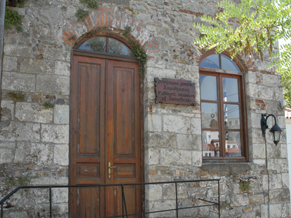
The Folklore Museum of Samothrace is located in Chora, housed in a two-story building and is of great interest. The foundation and enrichment of the Folklore Museum was initiated by the Municipality and the Cultural Association of Samothrace. On the ground floor of the museum you will see the paraphernalia of the "Kechaia" (as the cattle breeder is called in Samothrace), various agricultural tools, tools for the processing of thread and the traditional loom.
On the first floor of the Folklore Museum there is a representation of a Samothracian household, with mixed elements (folk and urban). It is a single room that houses the kitchen, the living room and the bedroom. A dominant position is occupied by the wooden "mesandra" of the early 20th century, the built-in wardrobe that existed in all Samothracian houses. The walls are decorated with "marhamades" (silk and cotton woven towels) and rich photographic material. The "corner" (kitchen) with the fireplace, the sofra and all the utensils a housewife needs to prepare food. The living room with the wooden sofa and coffee table (furniture that was only found in the homes of wealthy families). The 1929 iron bed covered with an all-silk blanket.
Local costumes of Samothrace are also exhibited in the Folklore Museum. The men's outfit consists of the tsirboulia (shoes), the kaltsun, the breeches, the znar (belt), the pkamsiou (shirt), the waistcoat, the aba (jacket) and the cap. The women's costume is very simple but beautiful. Blue or red or green simple skirt with a belt where two silver puffy buckles dominate in the center. On the head they wore a simple white scarf like a veil that fell on the back and shoulders over the long hair. You will also see beautiful chests and decorative plates that had come to the island mostly from the coasts of Asia Minor. Also rich is the collection of textiles with all-wool kilims, cotton layers, cotton silks and silks whose raw material was processed in Samothrace. And finally the wood-carved iconostasis of the beginning of the 20th century, which was not missing from any Samothrace house. The one on display at the Folklore Museum has rare icons from the last century that come from the island's churches, and is accompanied by a hanging candelabra and wreath case.
Editor: Fotini Anastasopoulou